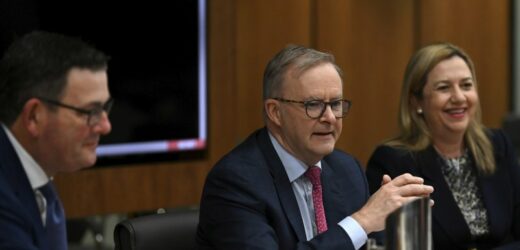Save articles for later
Add articles to your saved list and come back to them any time.
Prime Minister Anthony Albanese has promised $2.2 billion to launch the biggest overhaul of Medicare in its 40-year history while pledging to clamp down on ballooning costs in the National Disability Insurance Scheme.
Pharmacists and nurses will play a greater role in the health system, while new funding models will shift away from the traditional fee-for-service scheme that has driven how GPs are paid since the universal healthcare scheme began.
Prime Minister Anthony Albanese (centre), Queensland Premier Annastacia Palaszczuk and Victorian Premier Daniel Andrews during a national cabinet meeting on Friday.Credit: Dan Peled
There will also be a new Medicare patient ID for Australians – which will be voluntary – so they can register with their local doctor and the government can better understand the conditions that are driving people to emergency departments.
Albanese said state and territory leaders had confirmed health would be their “front and centre” concern for the rest of the year during the final national cabinet meeting before the May 9 federal budget, held in Brisbane on Friday.
Their commitments come as state hospital systems struggle under surging demand, GP bulk-billing rates decline every quarter, and out-of-pocket fees rise, threatening the affordability of Australia’s universal health system.
Albanese said state and federal governments had also agreed to curb spending on the NDIS – now the government’s second-fastest growing budget pressure – which is projected to cost $97 billion over the medium term.
The scheme, currently growing in cost at between 12 and 14 per cent a year as thousands more people join, will now have an 8 per cent annual growth target.
“We know that the trajectory of NDIS expenditure is just not sustainable into the future,” Albanese said.
“We need to have a sustainable growth trajectory for the NDIS in order to support equity and fairness for all Australians who are living with disability, including those not eligible for the NDIS, and ensure that every dollar goes to those who need it most.
“There are obvious issues with the way that the scheme is being administered.”
A further $720 million in the budget will be allocated to the National Disability Insurance Agency, which administers the NDIS, to enable it to boost its capacity and workforce, and improve the overall scheme.
A breakdown of the $2.2 billion health budget – which is a combination of old and new money – will be clearer on May 9.
But it will involve boosted funding, through primary health networks, to enable GPs to open after-hours as well as an investment in digital health.
The most dramatic change, however, involves extending what different parts of the health workforce can do and changing the way GPs are funded.
Albanese said blended funding models – which could see lump sum payments for GPs in addition to fee-for-service payments through Medicare rebates – will be introduced.
That funding will be enabled by a new and voluntary Medicare ID linking patients to their doctor, which could give a GP practice annual payments or other benefits when patients sign up for continued care.
There will also be flexible funding models that pay multidisciplinary teams of different health professionals.
The new measures are all recommendations of the Strengthening Medicare taskforce report, which was presented to the national cabinet at its February meeting.
“We will continue to … progress the recommendations and report back to the national cabinet,” Albanese said.
More to come
Cut through the noise of federal politics with news, views and expert analysis from Jacqueline Maley. Subscribers can sign up to our weekly Inside Politics newsletter here.
Most Viewed in Politics
From our partners
Source: Read Full Article



